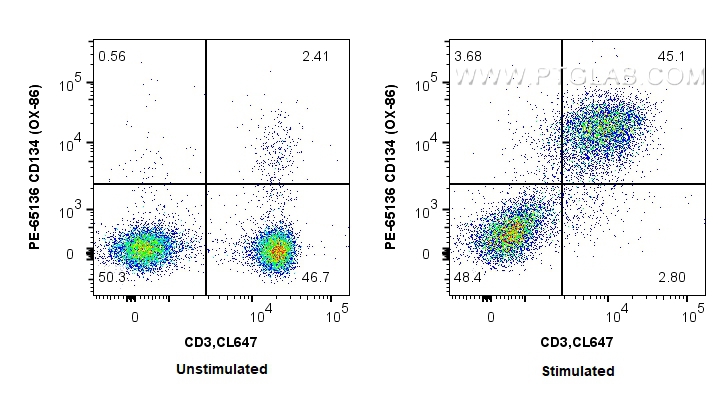验证数据展示
经过测试的应用
| Positive FC detected in | Anti-CD3/CD28 treated BALB/C mouse splenocytes |
推荐稀释比
| 应用 | 推荐稀释比 |
|---|---|
| This reagent has been tested for flow cytometric analysis. It is recommended that this reagent should be titrated in each testing system to obtain optimal results. | |
| Sample-dependent, Check data in validation data gallery. | |
产品信息
PE-65136 targets CD134/OX40 in FC applications and shows reactivity with mouse samples.
| 经测试应用 | FC Application Description |
| 经测试反应性 | mouse |
| 免疫原 | N/A 种属同源性预测 |
| 宿主/亚型 | Rat / IgG1, kappa |
| 抗体类别 | Monoclonal |
| 产品类型 | Antibody |
| 全称 | tumor necrosis factor receptor superfamily, member 4 |
| 别名 | Tnfrsf4, CD134, Txgp1, OX-86, Ox40 |
| GenBank蛋白编号 | BC065782 |
| 基因名称 | CD134 |
| Gene ID (NCBI) | 22163 |
| RRID | AB_3085013 |
| 偶联类型 | PE Fluorescent Dye |
| 最大激发/发射波长 | 496 nm, 565 nm / 578 nm |
| 形式 | Liquid |
| 纯化方式 | Affinity purification |
| 储存缓冲液 | PBS with 0.09% sodium azide and 0.5% BSA , pH 7.3 |
| 储存条件 | Store at 2-8°C. Avoid exposure to light. Stable for one year after shipment. |
背景介绍
CD134, also known as OX40 and TNFRSF4, is a member of the TNFR-superfamily of receptors (PMID: 2828930; 9766631). It is a type I transmembrane protein predominantly expressed on activated T cells which include CD4 and CD8 T cells, Th2, Th1, and Th17 cells, as well as regulatory T cells (Tregs) (PMID: 20307208). CD134 is activated by its cognate ligand CD134L (OX40L) and functions as a T cell co-stimulatory molecule (PMID: 26215166). CD134-CD134L interactions have been proposed as a potential therapeutic target for treating autoimmune diseases, cancer and infectious disease (PMID: 26215166; 19426222).
实验方案
| Product Specific Protocols | |
|---|---|
| FC protocol for PE CD134/OX40 antibody PE-65136 | Download protocol |
| Standard Protocols | |
|---|---|
| Click here to view our Standard Protocols |
